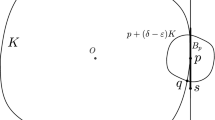Abstract
Given an n-dimensional lattice L and some target vector, this paper studies the algorithms for approximate closest vector problem (CVPγ) by using an approximate shortest independent vectors problem oracle (SIVPγ). More precisely, if the distance between the target vector and the lattice is no larger than c \( {\scriptscriptstyle \frac{c}{\gamma n}}{\uplambda}_1\left(\mathrm{L}\right) \) for arbitrary large but finite constant c > 0, we give randomized and deterministic polynomial time algorithms to find a closest vector, while previous reductions were only known for \( {\scriptscriptstyle \frac{c}{2\gamma n}}{\uplambda}_1\left(\mathrm{L}\right) \). Moreover, if the distance between the target vector and the lattice is larger than some quantity with respect to λ n (L), using SIVPγ oracle and Babai’s nearest plane algorithm, we can solve \( \mathrm{CVP}\upgamma \sqrt{n} \) in deterministic polynomial time. Specially, if the approximate factor γ ϵ (1, 2) in the SIVPγ oracle, we obtain a better reduction factor for CVP.
Similar content being viewed by others
References
Goldreich O, Micciancio D, Safra S, Seifert J P. Approximating shortest lattice vectors is not harder than approxi mating closest lattice vectors. Information Processing Letters, 1999, 71(2): 55–61.
Dinur I, Kindler G, Raz R, Safra S. Approximating CVP to within almost-polynomial factors is NP-hard. Combinatorica, 2003, 23(2): 205–243.
Haviv I, Regev O. Tensor-based hardness of the shortest vector problem to within almost polynomial factors. In Proc. the 39th Annual ACM Symp. Theory of Computing, June 2007, pp.469-477.
Kannan R. Minkowski’s convex body theorem and integer programming. Mathematics of Operations Research, 1987, 12(3): 415–440.
Ajtai M, Kumar R, Sivakumar D. Sampling short lattice vectors and the closest lattice vector problem. In Proc. the 17th IEEE Annual Conf. Computational Complexity, May 2002, pp.41-45.
Kannan R. Algorithmic geometry of numbers. Annual Review of Computer Science, 1987, 2: 231–267.
Banaszczyk W. New bounds in some transference theorems in the geometry of numbers. Mathematische Annalen, 1993, 296(1): 625–635.
Lyubashevsky V, Micciancio D. On bounded distance decoding, unique shortest vectors, and the minimum distance problem. In Lecture Notes in Computer Science 5677, Halevi S (ed.), Springer Berlin Heidelberg, 2009, pp.577-594.
Dubey C, Holenstein T. Approximating the closest vector problem using an approximate shortest vector oracle. In Lecture Notes in Computer Science 6845, Goldberg L A, Jansen K, Ravi R, Rolim J D P (eds.), Springer Berlin Heidelberg, 2011, pp.184-193.
Ajtai M. Generating hard instances of lattice problems (extended abstract). In Proc. the 28th ACM Annual Symp. Theory of Computing, May 1996, pp.99-108.
Regev O. On lattices, learning with errors, random linear codes, and cryptography. In Proc. the 37th Annual ACM Symp. Theory of Computing, May 2005, pp.84-93.
Blömer J, Seifert J. On the complexity of computing short linearly independent vectors and short bases in a lattice. In Proc. the 31st Annual ACM Symp. Theory of Computing, May 1999, pp.711-720.
Micciancio D. Efficient reductions among lattice problems. In Proc. the 19th Annual ACM-SIAM Symp. Discrete Algorithms, January 2008, pp.84-93.
Babai L. On lovász lattice reduction and the nearest lattice point problem. Combinatorica, 1986, 6(1): 1–13.
Micciancio D, Goldwasser S. Complexity of Lattice Problems: A Cryptographic Perspective. Kluwer Academic Publishers, 2002.
Klein P. Finding the closest lattice vector when it’s unusually close. In Proc. the 11th Annual ACM-SIAM Symp. Discrete Algorithms, January 2000, pp.937-941.
Cai J. A new transference theorem in the geometry of numbers and new bounds for Ajtai’s connection factor. Discrete Applied Mathematics, 2003, 126(1): 9–31.
Micciancio D. The geometry of lattice cryptography. In Lecture Notes in Computer Science 6858, Aldini A, Gorrieri R (eds.), Springer Berlin Heidelberg, 2011, pp.185-210.
Guruswami V, Micciancio D, Regev O. The complexity of the covering radius problem. Computational Complexity, 2005, 14(2): 90–121.
Author information
Authors and Affiliations
Corresponding author
Additional information
This work is partially supported by the National Basic Research 973 Program of China under Grant No. 2011CB302400, the National Natural Science Foundation of China under Grant Nos. 61379139 and 61133013, and the Strategic Priority Research Program of the Chinese Academy of Sciences under Grant No. XDA06010701.
Rights and permissions
About this article
Cite this article
Tian, CL., Wei, W. & Lin, DD. Solving Closest Vector Instances Using an Approximate Shortest Independent Vectors Oracle. J. Comput. Sci. Technol. 30, 1370–1377 (2015). https://doi.org/10.1007/s11390-015-1604-4
Received:
Revised:
Published:
Issue Date:
DOI: https://doi.org/10.1007/s11390-015-1604-4




